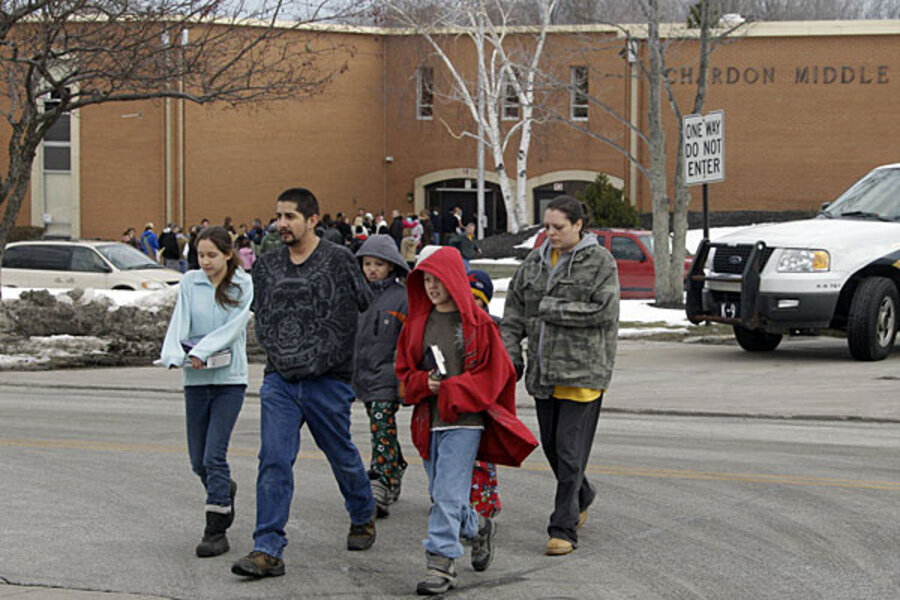Chardon High School shooting: what we've learned since Columbine
Loading...
At this point, it’s still unknown why a Chardon High School student walked into his school cafeteria Monday morning in a suburb of Cleveland and shot into a group of students, wounding four and killing one.
While reports and rumors fly as to whether or not the gunman had given any warning signs of what he was planning, or whether the students he shot at were targeted for a particular reason, it will take days and weeks to sort out just what happened, and what could have been done to prevent it.
Still, in the 13 years since the Columbine massacre pushed school shootings to the front of media headlines and many parents’ concerns, the trends seem to be improving in terms of student-initiated shootings. One possible reason: heightened awareness of the problem on the part of parents, teachers, and fellow students, who may be more willing to act on early warning signs.
“After the mid-90s when this became a major issue, I think now people have seen what can happen when you don’t report things and aren’t coming forward, and there’s a lot more awareness,” says Kevin Quinn, first vice president and public information officer for the National Association of School Resource Officers, and a resource officer at an Arizona high school. “I don’t think kids are as apt to keep things quiet anymore.”
This month, the federal government released the most recent Indicators of School Crime and Safety report, which puts school-related violent deaths at an all-time low since it began tracking such deaths in 1992. It reported 33 such deaths for the 2009-10 school year. Twenty-five of those were considered homicides – also the lowest since 1992 (tied with the 2002-03 school year). The 2006-07 school year had the highest number of deaths, with 63.
Still, those numbers – while the most comprehensive statistics available – don’t shed much light on school shootings, or on the specific sort of student-led shooting that seems to have occurred in Chardon. No central database of shooting incidents exists, and the incidents can vary so much by type – accidental shootings and suicides; gang-related shootings and those carried out by an adult shooter near a school or in a parking lot; those that don’t result in any deaths – that it can be hard to pin down exact numbers.
In the years leading up to Columbine, where 12 students and a teacher were killed in a carefully orchestrated attack by two seniors who then killed themselves, such shootings first started to gain attention. There were random shootings in places like Springfield, Ore.; Jonesboro, Ark.; and West Paducah, Ky., in which students killed and wounded dozens of fellow students and teachers.
Since Columbine, there have been others, although some of the most prominent and deadly – at Virginia Tech in 2007 and at Northern Illinois University in 2008 – were on college campuses, with older gunmen. Another particularly deadly incident occurred in Red Lake, Minn., on the Indian reservation there, when a 16-year-old boy killed 7 and wounded 5 at his high school, before killing himself.
“There do seem to be fewer [shootings], but the shift we’ve seen in the past few years has been more around the lone-wolf actor,” says Kenneth Trump, president of National School Safety and Security Services, a Cleveland-based consulting firm that specializes in school safety.
The common threads in today’s shootings, says Mr. Trump, often include a lone shooter who may not have given many indicators of what he is planning, undiagnosed and untreated mental health issues, and ballooning social media that can make it tougher for administrators and others to keep on top of any warning signs that do exist.
In the Chardon incident, Trump says there are already rumors that there may have been indicators on Twitter the night before the shooting, though nothing has been confirmed. But in other cases, he says, Twitter and Facebook are often where indicators surface.
One of the more recent school shootings also occurred in Northern Ohio, when a 14-year-old student at Cleveland’s SuccessTech Academy shot and wounded two fellow students and two teachers before killing himself.
A more recent incident that gained significant media attention occurred in Marinette, Wis., when a 15-year-old left his classroom to get guns from his locker, and returned to hold his class hostage for several hours. During a standoff with police, he shot himself in the head.
Despite the seeming decline in shootings, Trump says he’s concerned about several factors that could lead to more incidents in the future: the current focus on bullying rather than diagnosing and treating mental illness; the cut in funding for training and school safety programs; and the fact that the current generation of students and administrators – most of whom weren’t around when Columbine occurred – may have grown complacent.
“You add up those factors and it’s the perfect storm to start this whole cycle back up again,” says Trump.





